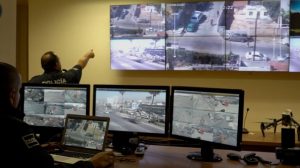As we reported last year, the City of Ensenada had enhanced its police protection with the collaboration of a state-of-the-art technology company based in Redwood City, California.
This collaboration, which utilized the services of a network of drones, was initiated by Mayor Marco Novelo on a trial basis to determine how much the company’s assistance could improve public safety in regards to crisis management and crime prevention.
The result was a drastic reduction in crime since the inception of the program in October of 2017, as reported by Mayor Novelo as late as June 2018.
The Mayor reported that as of that time, 513 arrests had been made as a result of patrols, and that management of crisis situations were greatly enhanced by, drone surveillance. By the time the program ended, over 1,000 arrests had been made as a result of drone intervention and guidance!
That Bay Area company is called Cape, which provided Ensenada with a network of drones that gave emergency services here unprecedented and incomparable coverage of the entirety of its large geographical area.
In order to appreciate the level of sophistication that Cape provided to the police and other emergency services, Gerardo Cervantes, Operations Manager at Cape, who also has an office locally in the Ensenada Business Center, said that a drone could be deployed to a within a 5km radius of a 911 call in less than three minutes!
Once the drone arrived at its assigned destination, its “eyes” on the situation provided critical information to the drone operator, revealing instantly what resources were necessary for adequate management of the emergency; for example, were fire trucks, ambulances or utility company’s services necessary, and, if so, what kind and how many of each? That information, rapidly communicated by dispatchers, could make the difference between life and death in critical situations.
Hector Elias is an Ensenada native who works with Cape locally. His “office” is underneath a palapa at Playa Hermosa, next to the circular building used by cruise ship tourists as an observation post!
Hector explained that the drones are so sophisticated that they can operate independently of an operator, i.e., if for some reason the operator is disconnected from the unit (which so far has never happened in a practical application), it will automatically return “home” – its original launching point – and land itself safely!
He works at that location daily, running tests and designing and upgrading new applications for Cape’s product line.
Cape drones have shown that they are indispensable allies to the local police department. They are also valuable assets to the military, private industry, large agricultural concerns, and private security companies.
Hector demonstrated one of the most desirable traits of Cape drones: They can be controlled remotely from anywhere in the world. As he stood beneath his palapa at Playa Hermosa, he pointed to a drone that was coming in for a landing; that drone was being piloted by a Cape operator in Redwood City!

Even though the municipal government is currently experiencing budgetary shortfalls, the Mayor is trying to get the federal government to allot funds to Ensenada to continue the program.
Hopefully, with the recent election of a progressive, forward-thinking president, that request will be granted.
It would behoove the feds to approve the request for the allocation of such funds, because, as the statistics from the trial have revealed, the reduction in crime and the more efficient allocation of emergency resources would more than pay for the cost of a partnership with Cape.
In the U.S., Cape is currently partnering with the city of San Diego for the UAS Pilot Integration Program, providing Cape-enabled drones to assist in emergency response support, offering the incomparable crime fighting and crisis management services that only a highly sophisticated squadron of drones can provide.
According to Mr Cervantes, the FAA’s flight pattern restrictions in the United States offer challenges more restrictive than those in Mexico, such as “line of sight,” but he is certain that Cape will be able to offer solutions to any challenge posed by that federal agency.
Line of sight seems an archaic restriction in the view of Cape’s worldwide network Internet coverage; Cervantes notes that he can be in Hawaii and control a drone in Ensenada!
As he says, with justifiable confidence, “There is no competition.”
Cape has an impressive website, that allows the viewer to fly a drone remotely! They’ve posted videos of example situations, like drones being used to catch burglars in the process of attempting to leave crime scenes with stolen goods, only to be surprised by the arrival of the police, who’d been notified by drone operators who “saw” the crime through the eyes of their technological partner in the sky!
There are also recorded images of crisis situations for which drones provided the information to dispatchers which allowed for the deployment of adequate resources to manage the situation.
It’s really a no-brainer: How can the city NOT continue to employ the services of a company which unquestionably enhances the safety of the public, while greatly assisting the police and other emergency systems?
In the long run, it’s probably one of the most “renewable” financial expenditures that could be considered by the government. It would more than pay for itself in the long run.
You can learn more about the company by visiting their website at: www.capedrones.com

